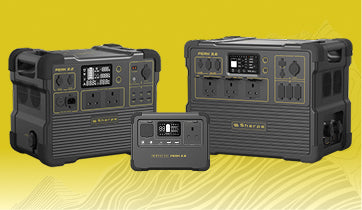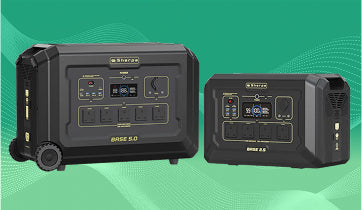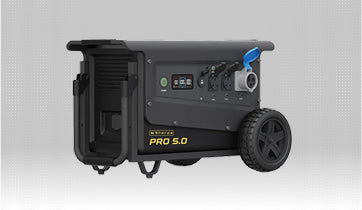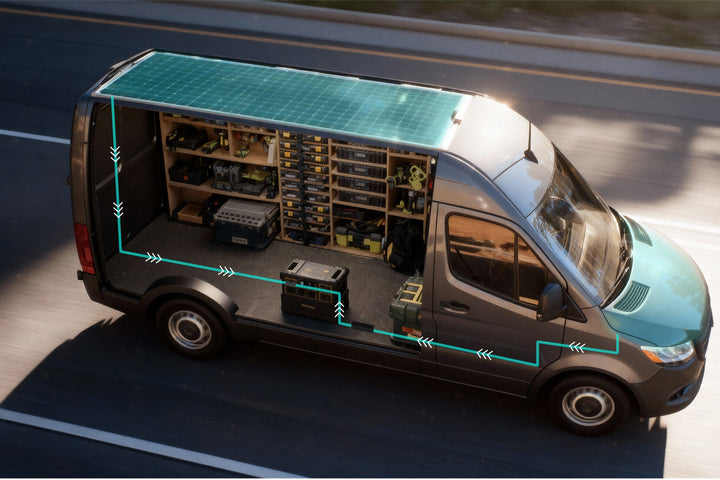FAQ
Do you ship overseas?
Yes, we ship as far as the European Union area.
How long will it take to get my orders?
Orders processed before 11am will take 1-3 business days to arrive with more remote areas taking 3 business days. Overseas deliveries can take up to 10 days. Delivery details will be provided in your confirmation email.
What is a portable power station?
A larger scale power bank incorporating an MPPT (solar controller), a battery and an inverter, along with various input and output ports.
They work in a similar way to a generator, allowing users to power devices and mains appliances where there is no access to grid mains power.
Battery sizes (energy capacity) and inverter ratings (output power) vary across different models to offer more cost effective and tailored solutions.
When might a portable power station be used?
They can be used for almost anything which requires a power supply when there is no access to mains power.
Predominantly with campervans, and motorhomes.
Businesses like to have off-grid power without the noise and smell of a generator which these products can provide.
Festivals often have a ‘no generator’ policy on site so access to power becomes difficult for the punters.
Back up during power cuts. Being without power is inconvenient at best. A portable power station can ensure that essential devices and emergency medical equipment can be kept running until grid power returns.
Many trades and fleets require vehicles to be adapted to have onboard power. Portable power stations are cost effective as they reduce installation costs.
Reduces the need for roadside idling and wasted energy.
To store energy when it is on a lower tariff or by solar generation and use it later.
What are Watt hours and amp hours?
A Watt (W) is a rate of power usage (in Joules per second).
A Watt hour (Wh) is a Watt of power spent every second for an entire hour.
A 2000Wh battery would allow you to run an appliance rated at 2000W for one hour or a 1000W appliance for 2 hours. All batteries however, reserve some capacity to maintain the cell life (15-20% for LFP batteries and 50% for lead acid) which is not usable.
A Watt is worked out by multiplying voltage (V) with amperage (A) (eg. 12V x 2 amps = 24W)
Watt hours can be converted to amp hours by dividing Wattage by voltage (eg. 1500Wh / 12V = 125Ah)
What does peak or surge power mean?
Certain devices, such as items with motors, use more power when they start up than what they use when they are running. A portable power station's surge power will allow a limited amount of extra power to start these devices.
Can a power station be charged by solar and mains at the same time?
Yes, our products will accept both types of charge at the same time, with priority given to the solar (or DC) charge so you save energy coming from the grid.
How do I convert Ah to Wh?
To convert Ah (amp hours) to Wh (Watt hours), you need to know the voltage of your battery and the nominal voltage of that will be a little higher. For example, a 12V battery may have a nominal voltage of 12.5V.
Use this simple formula:
Ah × V = Wh
(For kWh, divide the Wh by 1,000)
Example:
A 125 Ah power bank at 12.5V →
125 × 12.5 = 1562.5 Wh
So that portable power pack stores roughly 1.5 kilowatt-hours of energy.
How do I convert Wh to Ah?
If you want to know how many amp hours are equal a certain number of kilowatt hours, first find out the battery voltage. Again, this will be written as 12V but nominal voltages are a bit higher and 12.5 is a good average.
Wh ÷ V = Ah
Example:
A 2,000 Wh battery at 12.5V →
2,000 ÷ 12.5 = 160 Ah
Or 1.6 kWh
What’s the difference between Ah and kWh?
The answer is more to do with the type of power you use.
DC power or battery power is usually better understood in Ah
- Ah (amp hours) measures electrical charge -how much current a battery can supply over a period of an hour.
AC or mains power is measures in Watts and Watt hours
- Wh (Watt hours) measures energy use or storage - how much total power can be delivered over a period of an hour.
mAh is more common for small devices like phones or portable power banks, while kWh is used for larger systems such as home batteries, generators, and solar energy storage.
What’s the difference between AC and DC power?
In the UK, AC (alternating current) is what comes from your mains sockets — typically 230V AC. It’s ideal for powering household appliances.
DC (direct current), on the other hand, is the type of power stored in batteries and used by most electronics. Portable power stations often convert DC to AC so you can plug in standard UK devices safely.



